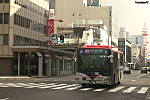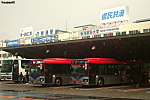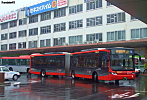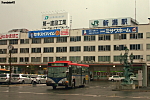Not logged in | Log in | Sign Up

Search Photos
Isuzu U-LV324K Cubic #G1426-I
27 december 2018 - Niigata (Niigata Pref.), Chūō-ku, Higashi-ōdōri 1-chōme, Prefectural Route 33.E46: 万代シティ (Bandai City) → 新潟駅前 (Niigata Station) → 新発田営業所 (Shibata Depot)
I also have, why not, this back then 23-year-old Cubic as a present. I think I might have mentioned this with the original Niigata series, but the operator over there has a habit of pushing older stock into its subsidiary, which is responsible for the typically suburban and regional routes. Given that the network is quite centralised around Niigata station, Bandai City bus terminal and the city hall, it doesn`t change much in terms of variety in the city centre itself, however there is a noticeable difference in the middle of nowhere, where low-floor buses don`t venture a whole lot (not that Niigata Kōtsū marks low-floor departures on timetables to begin with). Vertical traffic light as a bonus.


Author: TranslatorPS 

Place: 新潟市 [Niigata-shi] (Niigata-ken)
| Owner: Niigata Kōtsū Kankō Bus 新潟市 [Niigata-shi] | Route: E46
Comments: 2
Mitsubishi Fuso Aero Star #H1026-M
30 december 2018 - Niigata (Niigata Pref.), Chūō-ku, Hanazono 1-chōme (新潟県新潟市中央区花園1丁目), Niigata-eki-mae bus terminal stands.E22: 新潟駅前 (Niigata Station) → 新潟空港 (Niigata Airport)
Stand no. 9, occupied by the Mitsubishi Fusō, is dedicated entirely to E2x routes. The airport bus, E22, is the shortest route alongside E21 out of all twelve routes on this corridor. Aside from rte E22 and its rather uninspiring schedule (every 30-70 minutes Mon-Fri and every 50-60 Sat&Sun) and a price tag of 420 yen, there is also an "airport limousine" for the same price, but non-stop and much more frequently (every 20-40 minutes every day with some gaps). Personally I didn`t have to use it - I arrived in Niigata on the Shinkansen - but it`s interesting to see the airport connections compared to some European cities, especially those smaller than Niigata. In terms of impressive frequency one has to see the entire E2x corridor, where E22 amounts to barely anything.


Author: TranslatorPS 

Comments: 2
Mitsubishi Fuso Aero Star #H1208-M
30 december 2018 - Niigata (Niigata Pref.), Chūō-ku, Nishiboridōri 5-banchō (新潟県新潟市中央区西堀通5番町), National Route 116.W10: 新潟駅前 (Niigata Station) → 内野営業所 (Uchino Depot)
The W1x corridor operates every 15 minutes Mon-Fri and every 20 minutes Sat&Sun for most of the day (with higher frequencies in the peaks of course). However, there is a clear lack of pattern as to which route will operate - during daytime there is more W11 trips, but during the peaks there`s more W10s. I can still respect them sticking to a frequency on the corridor though.


Author: TranslatorPS 

Isuzu 2PG-LV290Q2 Erga Non-Step #H1127-I
30 december 2018 - Niigata (Niigata Pref.), Chūō-ku, Hanazono 1-chōme, bus station located in front of Niigata railway station (新潟県新潟市中央区花園1丁目).C31: 新潟駅前 (Niigata Station) → 西部営業所 (Seibu Depot)
Back to Niigata we go... Two Ergas (titular and H1047-I on rte W22) and another I-have-no-idea-what-it-is are loading passengers at the stands of Niigata-eki-mae bus stop. As seen in the photo, the buses are reversed into the stand entrances, which is good in terms of pulling out from the station, as well as given that passengers board via the back doors.
The bus network is built such that routes that operate mostly within the city terminate here. However, routes that operate outside of the built-up areas but still operated with city buses serve this stop en-route. Since they serve these reverse-entry stands, buses arriving here reverse in service with passengers on-board. However, staff on-site assist with the reversing process; they are also the ones to permit pax to enter the stand area. I don`t have any photos worth publishing from the reversing itself, however. The snow comes as a bonus.


Author: TranslatorPS 

Comments: 1
Scania K360UA 6x2/2LB / Volgren Optimus #001
27 december 2018 - Niigata (Niigata Pref.), Chūō-ku, Hanazono 1-chōme, Niigata station northside front (新潟県新潟市中央区花園1丁目).B10快速 (B10-kaisoku): 新潟駅前 (Niigata Station) → 青山 (Aoyama)
Nearly four months after my arrival in Japan and I finally find an articulated bus. Niigata Kōtsū has four of these bendy buses in their fleet, and they operate Rapid journeys on Niigata`s BRT as route B10...
But to be honest to call route B10 a BRT route is kind of an insult towards true BRT systems. The only things that make this route stand out above all the others in Niigata is the relatively high frequency (every 10 minutes for most of the day with peak-hours extras), a flat fare (210 yen unless travelling between Niigata station and Bandai bus terminal, then it`s 100 yen), and the occassional articulated buses. Other than that it`s pretty much the same as everything else - most of the route follows typical streets with only pieces of bus lanes in a few places. It was nice to listen to the European flavour for a change thanks to the Scania chassis, but everything else disappointed me completely given the branding created.


Author: TranslatorPS 

Comments: 1
Isuzu KC-LV380L Cubic #H26-I
30 december 2018 - Niigata (Niigata Pref.), Chūō-ku, Hanazono 1-chōme, Niigata station northside front (新潟県新潟市中央区花園1丁目).C80: 新潟駅前 (Niigata Station) → 新潟大学病院 (Niigata University Hospital)
Ladies and gentlemen, please do not adjust your receivers. If you`re seeing something that looks like a rather meager copy of the good old Berliet PR, everything is quite alright... the Japanese themselves admit that the design was based off the Berliet PR100. The difference is this, however: Renault finished with the PR100-esque front in 1993, Jelcz did so in 1996, while Isuzu kept the Cubic going on well into the year 2000. Apparently there are versions with somewhat normal middle doors...


Author: TranslatorPS 

Comments: 4
Isuzu LKG-LV234N3 Erga Non-Step #H716-I
30 december 2018 - Niigata (Niigata Pref.), Chūō-ku, Hanazono 1-chōme, Niigata station northside front (新潟県新潟市中央区花園1丁目).C20: 新潟駅前 (Niigata Station) → 西部営業所 (Seibu Depot)
Last time, I presented a few buses from Sado island. This time around however I`ll be showing some shots from Niigata itself, the capital of the prefecture by the same name. Niigata is a port city, one of a few sea gates towards Korea, north China, and Russia. Inhabited by some 810 thousand, the first mention of its name come from 1520. The Niigata port was one of the five that were to be first opened to international traffic in 1858 after the first international agreements that were to open Japan to the world after 250 years of closing itself off. One of the characteristic features of the city up until the second half of the previous century was the network of canals, the layout of which forms part of the current street network. Nowadays Niigata is mostly a rular-oriented city - it`s famous for the highest quality white rice across the country, for example. From a tourist`s point of view, I found it just slightly surprising to see tourist information provided in... Russian, although it makes sense given the city`s location.


Author: TranslatorPS 

Nissan Diesel PKG-RA274KAN / NSK 96MC #H398-N
27 december 2018 - Niigata (Niigata Prefecture), Chūō-ku, Bandai bridge (新潟県新潟市中央区万代橋), National Route 7. The company responsible for city and suburban buses in Niigata is Niigata Kōtsū Kabushiki-gaisha, a private company with quite the interesting shareholders (e.g. Bridgestone and Isuzu). The company is also the mother company of two other operators: Niigata Kōtsū Kankō Bus Kabushiki-gaisha, which is mostly in charge of the suburban routes as well as long-distance runs and private hire, as well as the already shown Niigata Kōtsū Sado Kabushiki-gaisha, which runs on Sado island. The fleet operated by the three companies is an absolute mixture, although the mother company seems to have the most of the newest fleet. The network in Niigata itself is sorted out on a sort of "tree" basis. Routes are numbered with three characters: the first, a letter, shows the cardinal direction (B for the BRT routes, more on that later; C for central Niigata; E, W, S are self-explanatory); the second, a digit, is a number distinguishing the particular "tree", and the last, also a digit, distinguishes the individual variation/route. With the exception of the B1x routes, fares are all distance-based. The entire network works on the rear-entry basis. As opposed to Sado island, here one can pay with a smart card.

Author: TranslatorPS 

Place: 新潟市 [Niigata-shi] (Niigata-ken)
| Owner: Niigata Kōtsū 新潟市 [Niigata-shi]
Comments: 2







